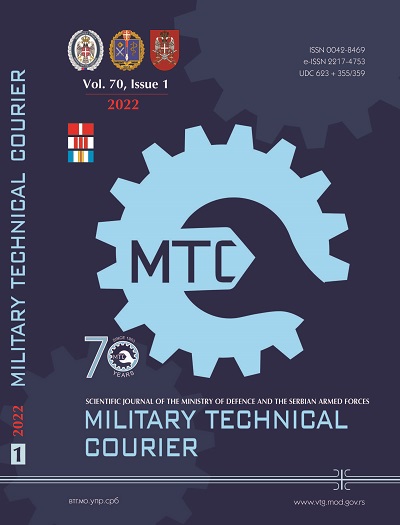Implementation of the digital training concept in the basic flight training in the Serbian Military Academy
Abstract
Introduction/purpose: The paper provides a review of recent research in the field of digital training applied in the Serbian Military Academy flight training. Flight training represents the foundation of successful education of military pilots. Its division is based on the environment and a phase of realization. The main part and the core of successful flight training is basic flight training. This training phase has experienced significant changes with the introduction of the Technically Advanced aircraft (TAA) which is characterized by a high degree of digitalization not only of the cockpit but also of other aircraft systems. Consequently, a different methodological approach to training is needed, including a digital training concept. The paper shows the achievements and certain solutions based on some elements of digital training concepts used in the basic flight training at the Serbian Military Academy.
Methods: The scientific approach is used in the evaluation of aircraft cockpit digitalization and in the implementation of a new training concept in the basic flight training in the Serbian Military Academy.
Results: Based on the methodological analysis used, the importance and the values of the digital training concept in basic flight training are shown.
Conclusion: Although the digital training concept is not mandatory in the existing flight training model in the Serbian Military Academy, it proves to be a valuable asset. Its potential is significant and, to a certain extent, it can change the nature of basic flight training. Due to digital training, cadets can fly more safely and their flying skills are acquired faster. In accordance with new modern aircraft acquisition in the Serbian Air Force, every aspect of the digital training concept has to be carefully considered, especially in the basic flight training phase, including conversion to new aircraft types.
References
Aysha, M. 2020. Microsoft Flight Simulator made more realistic thanks to 3D scanning. 3Dnatives, 27 October [online]. Available at: https://www.3dnatives.com/en/microsoft-flight-simulator-271020205/# [Accessed: 20 October 2021].
Chang-Geun, O. 2020. Pros and Cons of A VR-based Flight Training Simulator; Empirical Evaluations by Student and Instructor Pilots. Proceedings of the Human Factors and Ergonomics Society Annual Meeting, 64(1), pp.193-197. Available at: https://doi.org/10.1177/1071181320641047
Decker, T. 2013. Glass Cockpit Flight Training. Aviator college's Blog, 10 April [online]. Available at: http://aviatorcollege.wordpress.com/2013/04/10/glass-cockpit-flight-training/ [Accessed: 7 July 2021].
-Garmin. 2021. G500/G600 Series Trainer Base Install software version 1.2.0 [online]. Available at: http://www8.garmin.com/support/download_details.jsp?id=4867 [Accessed 15 October 2021].
-GOSA (The Governor's Office of Student Achievement). 2021. What is Digital Learning? [online]. Available at: https://gosa.georgia.gov/about-us/what-digital-learning [Accesed 28 September 2021].
Ison, D. 2016. Is Glass Safer? Plane & Pilot, 6 February [online]. Available at: https://www.planeandpilotmag.com/article/is-glass-safer/ [Accessed: 20 October 2021].
Jensen, K.T. 2020. Why Microsoft Flight Simulator 2020 Is This Year's Most Ambitious Game. PCMag, 18 August [online]. Available at: https://sea.pcmag.com/computer-console-gaming/38658/why-microsoft-flight-simulator-2020-is-this-years-most-ambitious-game [Accessed: 20 October 2021].
Kåre, L. & Sigbjørn, H. 2018. Excavating the origins of the learning pyramid myths. Cogent Education, (5)1, pp.1-17. Available at: https://doi.org/10.1080/2331186X.2018.1518638
Namestovski, Z. & Arsovic, B. 2013. Possibilities of implementing web 2.0 tools in education. In: International Conference on Information Technology and Development of Education – ITRO 2013, Proceedings, Zrenjanin, pp.43-45, June [online]. Available at: http://www.tfzr.rs/itro/Zbornik2013.pdf [Accessed: 20 October 2021].
-National Transportation Safety Board. 2010. Introduction of Glass Cockpit Avionics into Light Aircraft, Safety Study [online]. Available at: https://www.ntsb.gov/safety/safety-studies/Documents/SS1001.pdf [Accessed: 20 October 2021].
-Victoria State Government. 2021. Teach with digital technologies [online]. Available at: https://www.education.vic.gov.au/school/teachers/teachingresources/digital/Pages/teach.aspx#:~:text=Digital%20technologies%20are%20electronic%20tools,across%20all%20curriculum%20learning%20areas [Accesed: 28 September 2021].
Vlacic, S., Rodjenkov-Milinkovic, S., Knezević, A. & Vlacic, I. 2014. Use of the commercial software tools in the preparation phase of military pilot education and training. In: International Conference on Information Technology and Development of Education – ITRO 2014, Proceedings, Zrenjanin, pp.346-350, June [online]. Available at: http://www.tfzr.rs/itro/Zbornik_ITRO_2014.pdf [Accessed: 20 October 2021].
Vlačić, S. 2011. Training devices and flight simulators variants of application in pilots training on the aircraft Lasta. In: 4th International scientific conference on defensive technologies OTEH 2011, Belgrade, pp.143-146, October 6-7 [online]. Available at: http://www.vti.mod.gov.rs/oteh11/index.htm [Accessed: 20 October 2021].
Vlačić, S.I., Knežević, A.Z., Mandal, S., Rođenkov, S. & Vitsas, P. 2019. Improving the pilot selection process by using eye-tracking tools. Journal of Eye Movement Research, 12(3). Available at: https://doi.org/10.16910/jemr.12.3.4
Vlačić, S., Knežević, A. & Milutinović, M. 2015. Application of commercial available hardware in the making of flight trainer International Conference on Information Technology and Development of Education – ITRO 2015, Proceedings, Zrenjanin, pp.284-289, June [online]. Available at: http://www.tfzr.rs/itro/Zbornik%20ITRO%202015.pdf [Accessed: 20 October 2021].
-VRpilot. 2021. Virtual Reality & Flight Training [online]. Available at: https://vrpilot.aero/virtual-reality-flight-training/ [Accessed: 17 October 2021].
Proposed Creative Commons Copyright Notices
Proposed Policy for Military Technical Courier (Journals That Offer Open Access)
Authors who publish with this journal agree to the following terms:
Authors retain copyright and grant the journal right of first publication with the work simultaneously licensed under a Creative Commons Attribution License that allows others to share the work with an acknowledgement of the work's authorship and initial publication in this journal.
- Authors are able to enter into separate, additional contractual arrangements for the non-exclusive distribution of the journal's published version of the work (e.g., post it to an institutional repository or publish it in a book), with an acknowledgement of its initial publication in this journal.
- Authors are permitted and encouraged to post their work online (e.g., in institutional repositories or on their website) prior to and during the submission process, as it can lead to productive exchanges, as well as earlier and greater citation of published work (See The Effect of Open Access).

